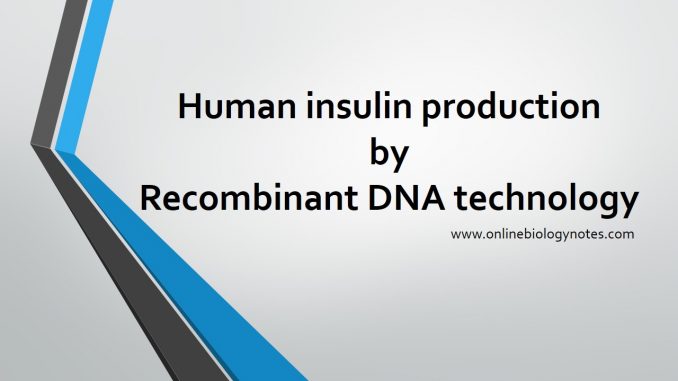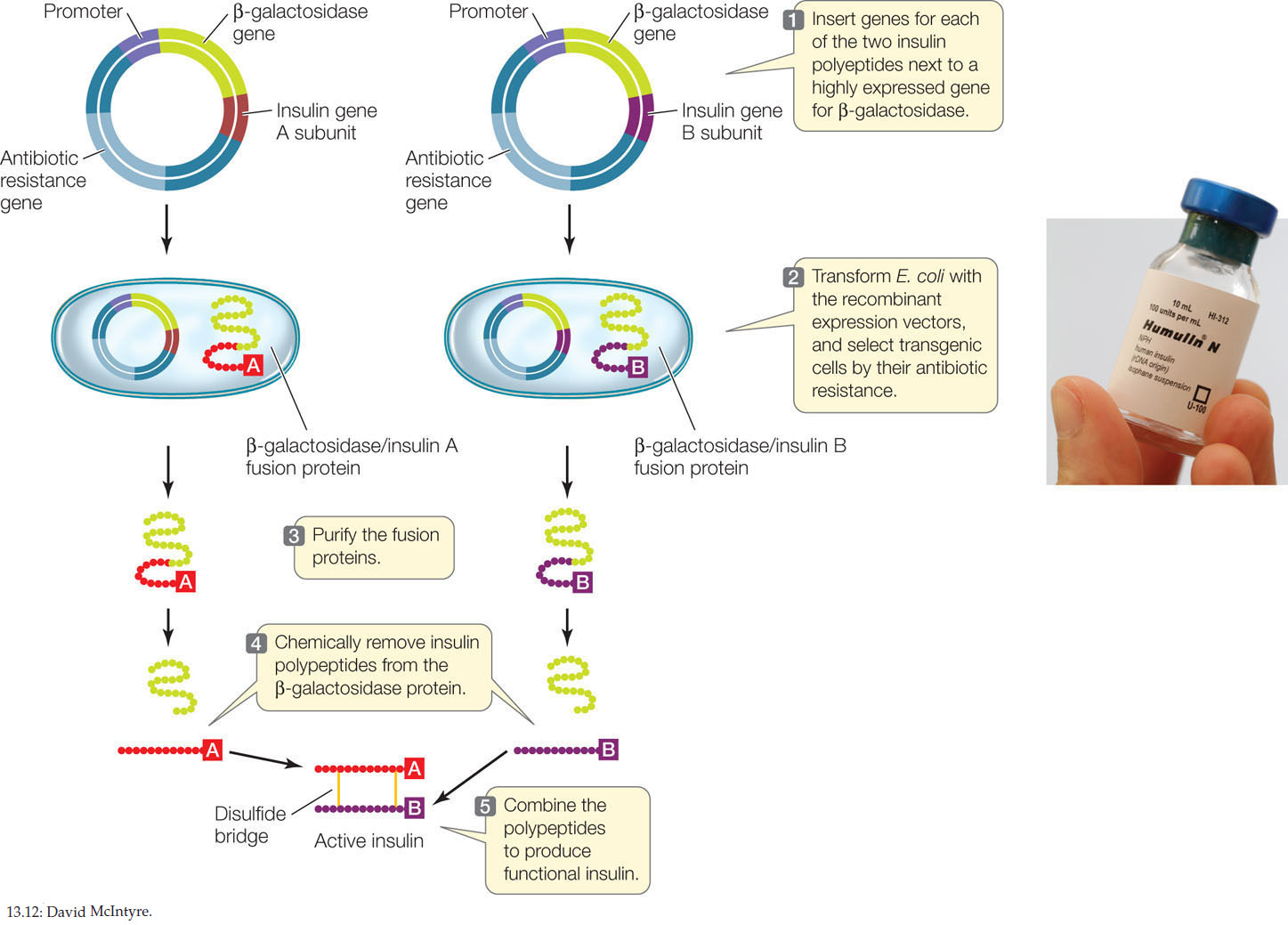
Human insulin production by genetic engineering
- Insulin is a hormone produced by β-cells of islets of Langerhans of pancreas. It was discovered by sir Edward Sharpey Schafer (1916) while studying Islets of Langerhans.
- Pancreas is a mixed gland situated transversely across the upper abdomen behind stomach and spleen.
- Insulin is a peptide hormone produced by pancreas and is a central regulator of carbohydrates and fat metabolism in the body.
Structure of Human Insulin:
- Chemically Human insulin is small, simple protein composed of 51 amino acids sequences and has a molecular weight of 5808 Da.
- Insulin hormone is a dimer of a A- chain and a B-chain which are linked together by a disulphide bond.
- Fredrick Sanger et al (1954) gave the first complete description of insulin. Insulin consists of two polypeptide chain,
o Chain A- 21 amino acids long
o Chain B-30 amino acids long
o Both chains are joined together by disulphide bond between two cysteine residue
Insulin produced inside pancreas:
- At first Pancreatic β-cells synthesize pre-pro-insulin, which is a 109 amino acids long polypeptide
- Among 109 amino acids, 23 amino acids are signal molecules which allows the pre-pro-insulin to pass through cell membrane.
- Entering inside cell, it become 86 amino acids long pro-insulin. It is still inactive.
- Some Proteolytic enzymes cut and expose the active site of pro insulin converting it into active form of insuin of 51 amino acids long.
Insulin produced by recombinant DNA technology.
- The basic step in recombinant DNA technology is similar for insulin production also.
- At first suitable vector (plasmid) is isolated from E. coli and then it is cut open by restriction endonuclease enzyme.
- The gene of interest (ie. Insulin coding gene) is isolated from β-cell and inserted in opened plasmid.
- Plasmid and gene of interest are recombined together by DNA ligase enzyme
- This recombined plasmid is inserted into suitable host cell (ie E. coli) and now this recombined host cell starts producing insulin hormone.
- Hakura et al (1977) chemically synthesize DNA sequence of insulin for two chains A and B and separately inserted into two PBR322 plasmid vector.
- These gene are inserted by the side of β-galactosidase gene of the plasmid.
- The recombinant plasmid were then separately transformed into E. coli host.
- The recombinant host produced pro-insulin chains ie. fused β-galactosidase-A chain and β-galactosidase-B-chain separately.
- These pro-insulin chains A and B were separated from β-galactosidase by treatment with cyanogen bromide. The detachment of pro-insulin chains from β-galactosidase is possible because an extra codon form methionine was added at N-terminal of each gene for A and B-chain.
- After detachment, A and B chains are joined invitro to reconstitute the naïve insulin by sulphonating the peptide chains with sodium disulphonate and sodium sulphite.

figure; diagrammatic representation of insulin production by genetic engineering
- Another method of insulin production by recombinant DNA technology is designed by Gilbert and Villokomaroff.
- In this method, m RNA for pre-pro-insulin is isolated from islets of Langerhans cell
- mRNA is reverse transcribed to form DNA and then it is inserted into PBR 322 plasmid in the middle of the gene for penicillinase.
- Then the recombinant plasmid is transformed into suitable host ie E. coli cell
- The host produced penicillinase + pre-pro insulin
- Insulin is later separated by trypsin treatment
Roles of insulin in body:
- Insulin causes cells in liver, skeletal muscles and fat tissue to take up glucose from the blood. In liver and skeletal muscle, glucose is stored as glycogen and in adipose tissue, it is stored as triglyceride.
- Insulin stops the use of fat as energy source by inhibiting the release of glucagon hormone.
- With the exception of the metabolic disorder such as Diabetes mellitus and metabolic syndrome, insulin maintain constant proportion of glucose in blood by removing excess glucose from the blood which otherwise would be toxic.
- When blood glucose levels fall below a certain level, body begins to use stored glycogen as energy source through glycogenolysis; which breaks down glycogen stored in liver and muscles into glucose, which is then utilized as energy source.
- Failing to control the level of insulin in body results in a disorder called diabetes mellitus. As a consequences Insulin is used medically to treat some forms of diabetes mellitus.
- Patients with type I diabetes depends on insulin shots. Most commonly insulin is injected subcutaneously for the patients because the hormone is no longer produced in their body. Type I diabetes is also known as Insulin dependent diabetes mellitus.
- Patients with type II diabetes are often resistant to insulin and because of such resistance many suffer from relative insulin deficiency. This is also known as Insulin independent diabetes. Some patients with type II diabetes may eventually require insulin shots if other medication fails to control blood glucose level. Over 40% of type II diabetes patients require insulin shots as part of their diabetes management plan.
